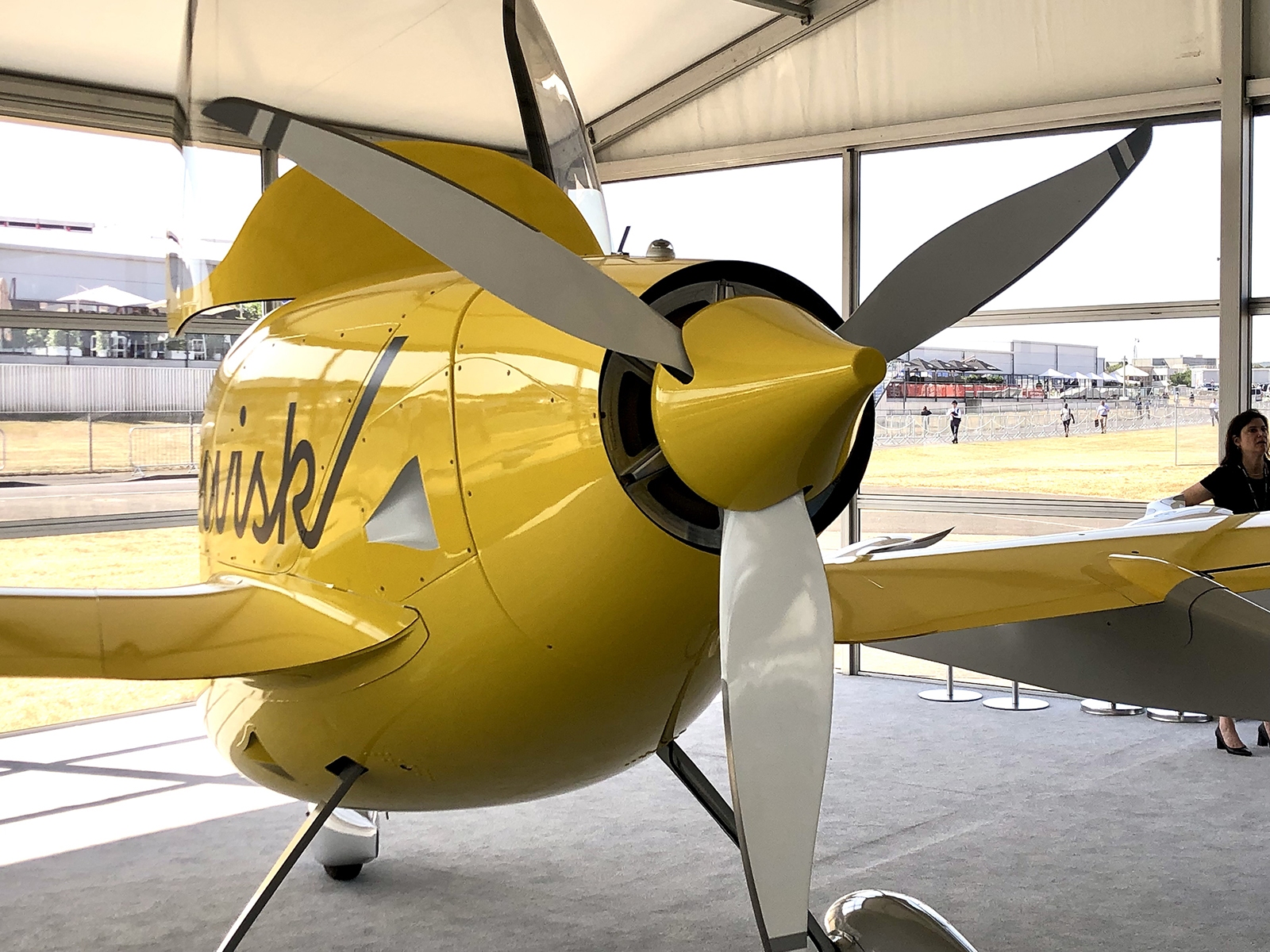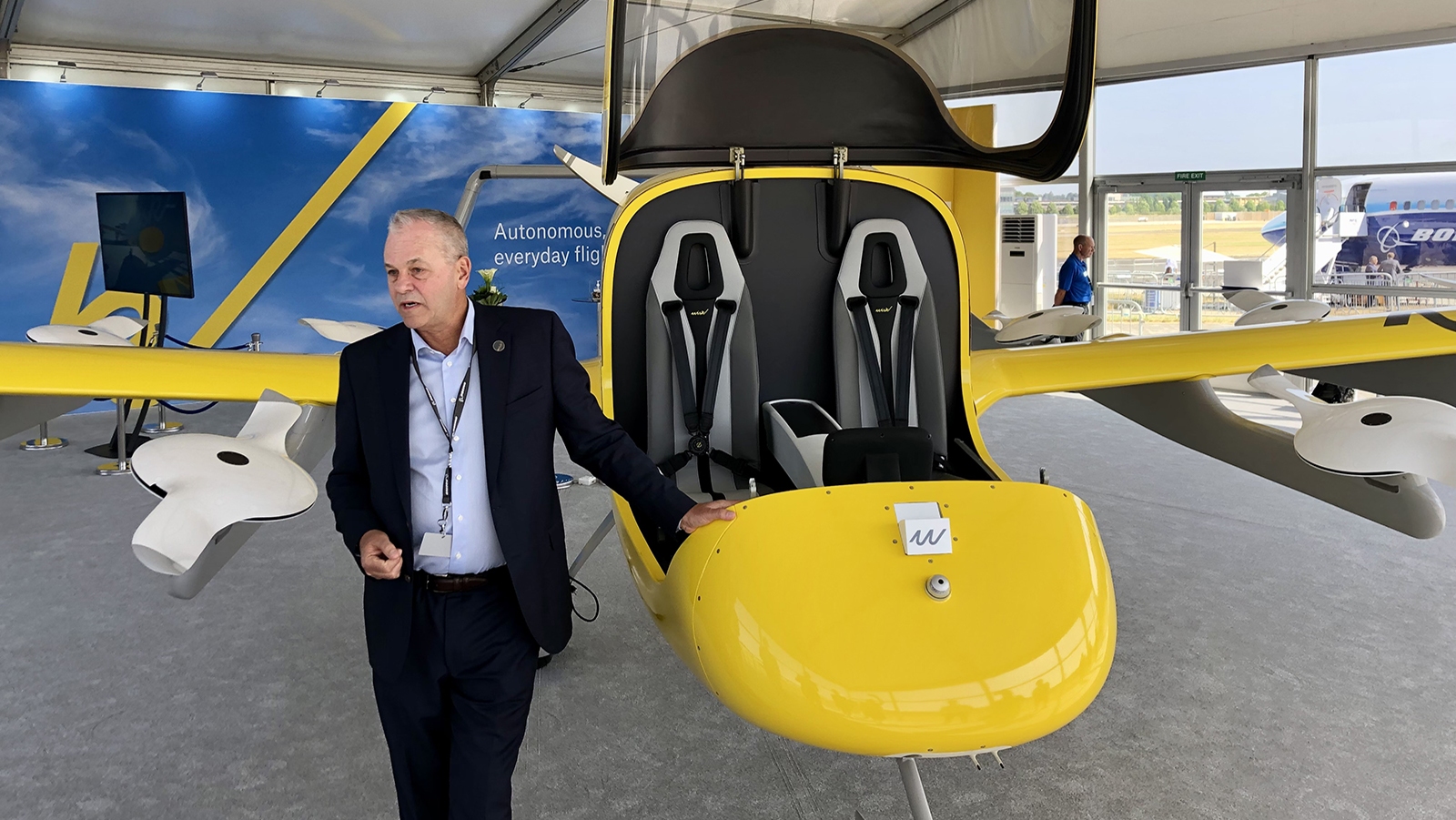Stay Up to Date
Submit your email address to receive the latest industry and Aerospace America news.
Production version will have more seats than the demonstrators
FARNBOROUGH AIRSHOW, Farnborough, U.K. — Inside its company tent here, California-based Wisk Aero showed off one of the electric test aircraft it has flown over the years and announced plans to reveal in October the first production aircraft of its next-generation design.
This version of the eVTOL, or electric vertical takeoff and landing, aircraft will have four seats instead of the two in the Cora test aircraft on display.
During the unveiling at Wisk’s flight testing facilities at Hollister Municipal Airport in California, “we will give more details about our Gen Six aircraft, which is all we are calling it for now, and which is expected to be our production model as we continue working with FAA” toward type certification, CEO Gary Gysin told me.
While loud jets took off on the runway, periodically drowning out conversation, Gysin emphasized the convenient, emission-free, relatively quiet performance of the Wisk vehicles, even if they aren’t targeting the same market as the jets.
“The problem we’re solving is a really congested city problem, where you stay in your car for an hour and a half, two hours or whatever, and you don’t have the predictability of when you’re going to actually get to where you want to be,” Gysin said.
Gysin said today’s helicopters are too noisy for widespread use as air taxis, so the Wisk vehicle could penetrate urban markets that restrict helicopter use.
“For example, in San Francisco there are 32 unused helicopter pads because they don’t want the noise there,” he said. “Our vehicles will fly overhead with an ambient noise from a highway a mile away.”
The Wisk aircraft will take off vertically like a helicopter propelled by 12 electric rotors, or lift fans.
Once it reaches the desired elevation, a pusher propeller at the rear of the eVTOL will drive it forward, said Brian Yutko, Boeing vice president and chief engineer for sustainability and future mobility.
“At that point, the 12 lift fans stop and lock into aerodynamic position for flight,” Yutko said. “There’s are very few people who have accomplished this.”
Although dozens of companies are pursuing vertical takeoff and landing designs, only a few have achieved midair transition from vertical to forward flight. Others are California-based Joby Aviation and Germany-based Lilium.
Boeing owns more than half of Wisk, although the exact portion hasn’t been disclosed, and has invested at least $450 million in the startup. Yutko said Boeing has around 100 people working on the Wisk aircraft alongside Wisk’s 400 employees.
“The Wisk team has managed to achieve transition within about 25 seconds after takeoff and ascent to about 12 meters,” Yutko said. “That is super quick, and it’s super hard to actually do that with automated software, but they’ve done it.”
All AAM companies plan for highly automated aircraft, but only Wisk plans to move directly to passenger flights without a pilot on board. A Wisk pilot, who may later become simply a flight manager, would monitor flights from the ground and take over control in the event of an emergency, Gysin said. Passengers will be able to speak to the pilot via radio.
Other companies are planning for piloted service and a transition to flights without a pilot on board later. Yutko and Gysin said they realize that might mean other companies offer air taxi service earlier than Wisk, but they believe automated flight without an onboard pilot will be the key to long-term success.
Wisk is one of the only AAM companies that hasn’t publicly declared when it hopes to receive FAA type certification for its aircraft, with officials saying they prefer not to raise public expectation or pressure on engineers when FAA is the authority on certification.
But Gysin said it’s possible Wisk will fly a demonstrator aircraft at the 2023 Paris Air Show.
Once certification is achieved, Gysin said he has plans for Wisk to begin mass production. The company hasn’t chosen a location for such a facility, but it won’t be in California, he said.
“Within five years of entering service, we will build 2,000 aircraft and move 40 million people, which seems like a lot, but it’s a lot of quick hop flights,” he said.
Get the latest news about advanced air mobility delivered to your inbox every two weeks.
About paul brinkmann
Paul covers advanced air mobility, space launches and more for our website and the quarterly magazine. Paul joined us in 2022 and is based near Kennedy Space Center in Florida. He previously covered aerospace for United Press International and the Orlando Sentinel.
Related Posts
Stay Up to Date
Submit your email address to receive the latest industry and Aerospace America news.





